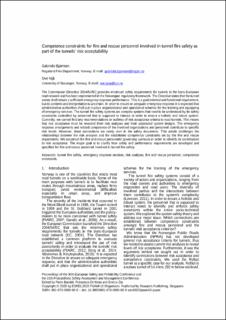Competence constraints for fire and rescue personnel involved in tunnel fire safety as part of the tunnels risk acceptability
Chapter
Accepted version
Permanent lenke
https://hdl.handle.net/11250/3050426Utgivelsesdato
2020Metadata
Vis full innførselSamlinger
Originalversjon
Bjørnsen, G., & Njå, O. (2020). Competence constraints for fire and rescue personnel involved in tunnel fire safety as part of the tunnels’ risk acceptability. In Proceedings of the 30th European Safety and Reliability Conference and the 15th Probabilistic Safety Assessment and Management Conference.Sammendrag
The Commission Directive 2004/54/EC provides minimum safety requirements for tunnels in the trans-European road network and has been implemented in the Norwegian regulatory framework. The Directive states that the tunnel owner shall ensure a sufficient emergency response performance. This is a goal oriented and functional requirement, but its contents and interpretation is uncertain. In order to ensure an adequate emergency response it is expected that administrative authorities shall put in place organizational and operational schemes for the training and equipping of emergency services. The tunnel fire safety systems are complex systems that need to be understood by its safety constraints controlled by personnel that is supposed to interact in order to ensure a holistic and robust system. Currently, we cannot find any recommendations or outlines of risk acceptance criteria to road tunnels. This means that risk acceptance must be revealed from risk analyses and their associated system designs. The emergency response arrangements and related competence of the involved organizations and personnel contribute to specific risk levels. However, these connections are rarely seen in the safety documents. This article challenges the relationships between the risk analyses and the established competence constraints set by the fire and rescue departments. We scrutinize the fire and rescue personnels' governing curricula in order to identify its contribution to risk acceptance. The major goal is to clarify how safety and performance requirements are developed and specified for fire and rescue personnel involved in tunnel fire safety.
